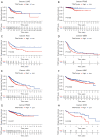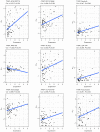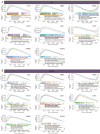A comprehensive pan-cancer analysis on the immunological role and prognostic value of TYMP in human cancers
- PMID: 36237259
- PMCID: PMC9552085
- DOI: 10.21037/tcr-22-502
A comprehensive pan-cancer analysis on the immunological role and prognostic value of TYMP in human cancers
Abstract
Background: The TYMP gene encodes an important nucleoside metabolism enzyme which is a rate-limiting enzyme for chemotherapeutic drug metabolism. Previous studies have shown that TYMP is highly expressed in many different tumors, promoting invasiveness and progression, and that it helps to predict the response to chemotherapeutic drugs. However, the role of TYMP in tumor immunity and prognosis remains largely unclear. The purpose of this pan-cancer analysis was to acquire more data on the function of TYMP function and its clinical significance.
Methods: To access the TYMP expression, we accessed datasets from The Cancer Genome Atlas (TCGA), Oncomine, Gene Expression Profiling Interactive Analysis (GEPIA), Cancer Cell Line Encyclopedia (CCLE) databases, and analyzed its differential expression between paired tumor and normal samples. We employed PrognoScan and Kaplan-Meier plotter for survival analyses. TYMP mutations were analyzed using cBioPortal. Correlations of TYMP with tumor stage, tumor mutational burden (TMB), microsatellite instability (MSI), immune checkpoint genes (ICGs), and immune cell infiltration were estimated via bioinformatics tools and methods. The CellMiner database was used to predict drug response. Gene set enrichment analysis (GSEA) was applied to explore the biological functions of TYMP in different tumors.
Results: Our results indicated that TYMP was overexpressed and also significantly associated with a worse prognosis in several human cancers, such as kidney clear cell carcinoma (KIRC) and lower grade glioma (LGG). TYMP was also associated with TMB, MSI, and ICGs across a variety of malignancies. TYMP was most significantly correlated with immune cell infiltration in five tumors, namely, breast cancer (BRCA), cervical cancer (CESC), KIRC, skin cutaneous melanoma (SKCM), and stomach adenocarcinoma (STAD). Moreover, TYMP expression predicted sensitivity to chemotherapy drugs and also influenced relevant biological pathways, according to enrichment analysis.
Conclusions: According to the results of this comprehensive analysis, TYMP is associated with prognosis and tumor immunology, which might make it be a potential therapeutic target for cancer treatment.
Keywords: TYMP; immune infiltration; pan-cancer analysis; prognosis; tumor mutational burden (TMB).
2022 Translational Cancer Research. All rights reserved.
Conflict of interest statement
Conflicts of Interest: All authors have completed the ICMJE uniform disclosure form (available at https://tcr.amegroups.com/article/view/10.21037/tcr-22-502/coif). The authors have no conflicts of interest to declare.
Figures










Similar articles
-
Identification of SHCBP1 as a potential biomarker involving diagnosis, prognosis, and tumor immune microenvironment across multiple cancers.Comput Struct Biotechnol J. 2022 Jun 18;20:3106-3119. doi: 10.1016/j.csbj.2022.06.039. eCollection 2022. Comput Struct Biotechnol J. 2022. PMID: 35782736 Free PMC article.
-
Pan-Cancer Analysis of PARP1 Alterations as Biomarkers in the Prediction of Immunotherapeutic Effects and the Association of Its Expression Levels and Immunotherapy Signatures.Front Immunol. 2021 Aug 31;12:721030. doi: 10.3389/fimmu.2021.721030. eCollection 2021. Front Immunol. 2021. PMID: 34531868 Free PMC article.
-
[Pan-cancer analysis of ubiquitin-specific protease 7 and its expression changes in the carcinogenesis of scar ulcer].Zhonghua Shao Shang Yu Chuang Mian Xiu Fu Za Zhi. 2023 Jun 20;39(6):518-526. doi: 10.3760/cma.j.cn501225-20230421-00137. Zhonghua Shao Shang Yu Chuang Mian Xiu Fu Za Zhi. 2023. PMID: 37805766 Free PMC article. Chinese.
-
Pan-cancer analysis of the prognostic and immunological role of GJB2: a potential target for survival and immunotherapy.Front Oncol. 2023 Jun 23;13:1110207. doi: 10.3389/fonc.2023.1110207. eCollection 2023. Front Oncol. 2023. PMID: 37427102 Free PMC article. Review.
-
A Pan-Cancer Analysis Reveals the Prognostic and Immunotherapeutic Value of Stanniocalcin-2 (STC2).Front Genet. 2022 Jul 22;13:927046. doi: 10.3389/fgene.2022.927046. eCollection 2022. Front Genet. 2022. PMID: 35937984 Free PMC article. Review.
Cited by
-
Exploring the role of CD8+ T cells in clear renal cell carcinoma metastasis.FEBS Open Bio. 2024 Jul;14(7):1205-1217. doi: 10.1002/2211-5463.13819. Epub 2024 Jun 13. FEBS Open Bio. 2024. PMID: 38872260 Free PMC article.
-
Evaluation of Clinically Significant miRNAs Level by Machine Learning Approaches Utilizing Total Transcriptome Data.Dokl Biochem Biophys. 2024 Jun;516(1):98-106. doi: 10.1134/S1607672924700790. Epub 2024 Mar 27. Dokl Biochem Biophys. 2024. PMID: 38539010
-
Thymidine phosphorylase in nucleotide metabolism: physiological functions and its implications in tumorigenesis and anti-cancer therapy.Front Immunol. 2025 Apr 15;16:1561560. doi: 10.3389/fimmu.2025.1561560. eCollection 2025. Front Immunol. 2025. PMID: 40303404 Free PMC article. Review.
-
Causal association between plasma proteins and lung adenocarcinoma: a two-sample mendelian randomization study.BMC Pulm Med. 2025 Jun 4;25(1):280. doi: 10.1186/s12890-025-03751-5. BMC Pulm Med. 2025. PMID: 40468286 Free PMC article.
-
A Proteomics Approach Identifies RREB1 as a Crucial Molecular Target of Imidazo-Pyrazole Treatment in SKMEL-28 Melanoma Cells.Int J Mol Sci. 2024 Jun 20;25(12):6760. doi: 10.3390/ijms25126760. Int J Mol Sci. 2024. PMID: 38928466 Free PMC article.
References
LinkOut - more resources
Full Text Sources
